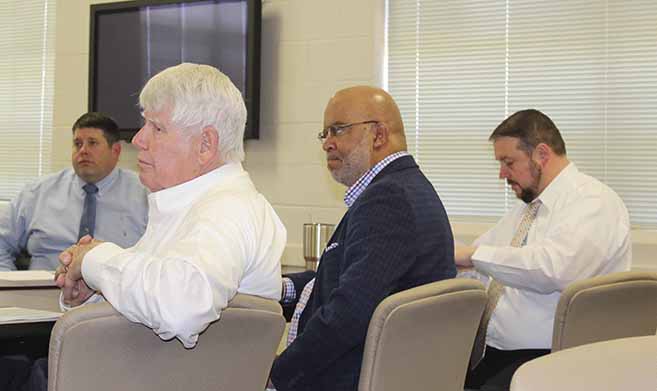
City officials hear ‘state of the state of schools’
By DON FLETCHER
News Staff Writer
Note: Today’s article is the first in a three-part series on the Escambia County Board of Education’s effort to publicize the amount of improvement under gone at the three schools inside Atmore’s city limits, as well as plans to improve the areas at each school where weaknesses might still exist.
Escambia County Superintendent of Education John Knott didn’t say it, but his constant glances toward Atmore Mayor Jim Staff and City Councilmen Webb Nall and Chris Walker, along with his closing comments, revealed his obvious disappointment that the three were the only municipal representatives at the special March 20 presentation.
The get-together was designed to inform city officials of the current situations at the three schools within Atmore’s municipal boundaries.
“Today we’re here as an opportunity to present to Atmore’s mayor and city council kind of a ‘state of the state of schools,’ how we formulated our plan of action and what we did trying to come up with a plan,” said Knott, who noted that the special presentation was not an answer to the call for a city school system. “This is not a meeting about whether the City of Atmore wants to pursue looking into a city school system. They have that right, and I respect that right.
“But that’s not what we’re here for. We want to be able to make sure (city officials) are fully informed of exactly what we’re doing, exactly what we have to offer, where we started and how far we’ve come.”
Knott displayed statistical proof of the improvement shown in areas from the graduation rate at ECHS, which showed a 67 percent mark in 2013 and reached the 93 percent mark last year, to the impact on the local economy that is created by students in cooperative programs, where they work with various businesses or industries as part of their class work.
He explained that 19 students currently are in the co-op program. If each student worked 15 hours per week over the 43-week school year, at minimum wage ($7.25 per hour), those students would earn a collective $88,848.75. Using a multiplier of 7 (the number of times local dollars are projected to turn over in the economy), the total impact would be $621,941.25.
He also cited other financial statistics, including the loss to local schools from inclusion on the Alabama Failing Schools list, which is based on the result of a single test taken by a single grade-level.
Knott noted that the Alabama Accountability Act, which determines the schools that are on the list, diverts money from those schools to independent educational institutions.
“The money diverted from our schools goes to charter schools, private schools and church schools,” he said. “At first (the Act) sounded like a way to help students in areas where the schools are struggling. In reality, all it did was pull money out of the schools that needed the money to make improvements and gave it to private schools or donors of scholarships.
“Since the Act came into effect, over $845,000 has come directly out of the Escambia County School System budget. It’s siphoning money directly out of a system like ours to fund private schools. It has not helped any students going to Escambia County schools.”
Knott, Assistant Superintendent Beth Drew and the principals of the three Atmore schools — Dennis Fuqua of ECHS; Debbie Bolden of ECMS; John Brantley of RPES — each were given the floor to tout the improvement realized over the past three years by their respective schools.
Other Central Office administrators also contributed to the conversation, each adding a layer to the proof of improvement. Finally, as the presentation neared the two-hour mark, Knott brought it to an end with a plea to the three city officials in attendance.
“I could stay here for hours more, talking about the things that we do in our schools and the programs we offer,” he said directly to Staff, Nall and Walker. “We felt like it was really important to try and share our story with the people here and you can go out and share some of the things we shared with you today.
“We invite, we encourage, we beg for you and the rest of the council members to call these principals and let’s do some tours in the schools. When you see exactly what’s going on, it will tell you exactly what we’re doing.”
Next week: Some of the statistical proof of the improvements at each school within Atmore’s city limits.
